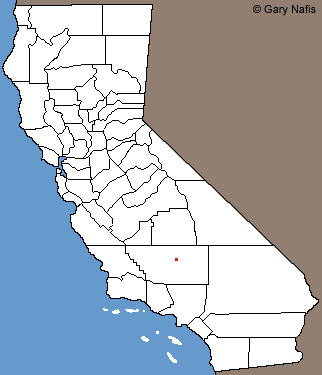|
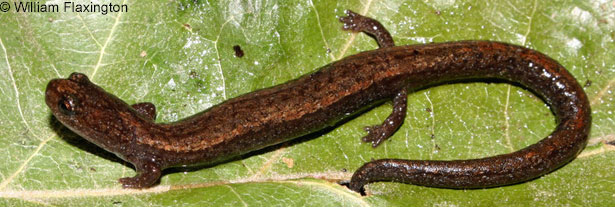 |
| Adult, 5,700 ft. Kern County, © William Flaxington |
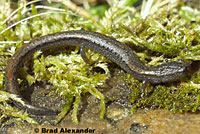
|
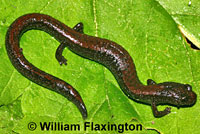 |
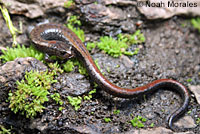 |
Adult, Kern County,
© Brad Alexander |
Adult, 5,700 ft. Kern County, © William Flaxington |
Adult, Kern County
© Noah Morales |
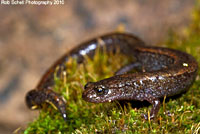 |
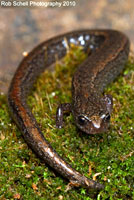 |
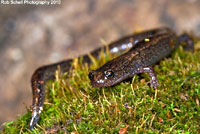 |
| Adult, Kern County © Rob Schell |
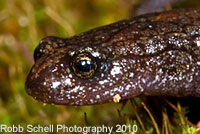 |
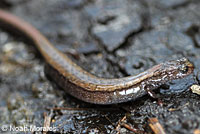 |
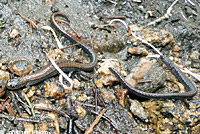 |
| Adult, Kern County © Robb Schell |
Adult, Kern County
© Noah Morales |
Adults, Kern County
© Jonathan Hakim |
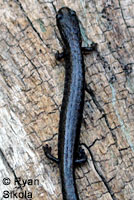 |
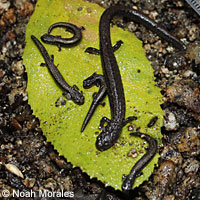 |
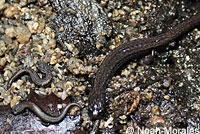 |
| Adult, Kern County © Ryan Sikola |
Adult and juveniles, Kern County. This species is rarely found far from surface water, and some of these juveniles were found fully submerged in water.
© Noah Morales |
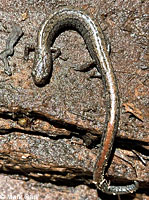 |
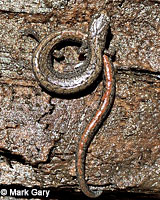 |
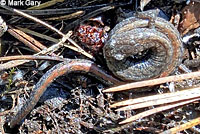 |
Adult, 5,700 ft., Kern County
© Mark Gary |
Adult, Kern County, in a defensive coil.
© Mark Gary |
| |
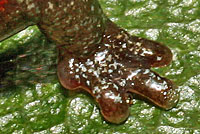 |
|
| |
Slender Salamanders (genus Batrachoseps) have only 4 toes on their hind feet. All other California salamanders have 5 toes on their hind feet. |
|
| |
|
|
| Comparison with a Possible Sympatric Slender Salamander |
| |
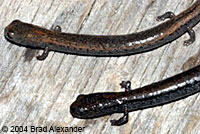 |
|
| |
Top: B. gregarius - Gregarious Slender Salamander
Bottom: B. relictus
The ranges of these species might overlap. Note the larger, more robust body and limbs on B. relictus.
© 2004 Brad Alexander |
|
| |
| Habitat |
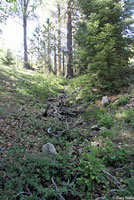 |
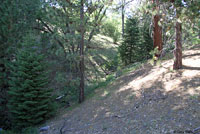 |
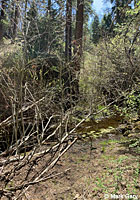 |
| Habitat, 6,500 ft. Kern County |
Habitat, 6,500 ft. Kern County |
Habitat, 5,700 ft. Kern County
© Mark Gary |
|
|
|
| Description |
| |
| Size |
(From B. relictus) Adults are 1 3/8 - 1 7/8 inches long (3.5 - 4.7 cm) from snout to vent.
|
| Appearance |
A small slim salamander with 16-20 costal grooves.
Short limbs, a long slender body with a narrow head and a long tail, and conspicuous costal and caudal grooves give this species the worm-like appearance typical of most Slender Salamanders.
There are four toes on the front and hind feet, which is also typical of Slender Salamanders.
(Other California salamanders have five toes on the hind feet.) |
| Color and Pattern |
Color is blackish brown with a reddish, yellowish, or dark brown dorsal stripe which is often not visible in large animals.
|
| Life History and Behavior |
A member of family Plethodontidae, the Plethodontid or Lungless Salamanders.
Plethodontid salamanders do not breathe through lungs. They conduct respiration through their skin and the tissues lining their mouth. This requires them to live in damp environments on land and to move about on the ground only during times of high humidity. (Plethodontid salamanders native to California do not inhabit streams or bodies of water but they are capable of surviving for a short time if they fall into water.)
Plethodontid salamanders are also distinguished by their nasolabial grooves, which are vertical slits between the nostrils and upper lip that are lined with glands associated with chemoreception.
All Plethodontid Salamanders native to California lay eggs in moist places on land.
The young develop in the egg and hatch directly into a tiny terrestrial salamander with the same body form as an adult.
(They do not hatch in the water and begin their lives as tiny swimming larvae breathing through gills like some other types of salamanders.)
|
| Activity |
Little is known about this species.
Most Slender Salamander species are active on rainy or wet nights when temperatures are moderate, fall through spring, retreating underground when the soil dries or when air temperature drops to near freezing.
Due to the high elevation habitat of this species, activity may be restricted to spring, early summer and early fall.
Salamanders on Breckenridge Mountain have been found active on the surface from May to early October.
In the former Lower Kern River Canyon populations, moisture from perennial springs probably allowed activity throughout most of the year.
Found under rocks, logs, bark, and other surface debris, including large pine cones.
This species is usually associated with seepages and springs and appears to prefer very wet conditions, often found directly in water, which is very unusual for any species of slender salamander. It has rarely been found beyond surface water. |
| Defense |
Slender salamanders use several defense tactics, including:
- Coiling and remaining still, relying on cryptic coloring to avoid detection.
- Uncoiling quickly and springing away repeatedly bouncing over the ground, then remaining still again to avoid detection.
- Detaching the tail, which wriggles on the ground to distract a predator from the salamander long enough for it to escape.
(After its tail is detached or severed, the salamander will grow a new tail.) |
| Diet and Feeding |
Most likely eats a variety of small invertebrates.
Feeding behavior is not well known, but other Batrachoseps species are sit-and-wait predators that use a projectile tongue to catch prey. |
| Reproduction |
Little is known yet of the life history of this species.
It is presumed that it is similar to other slender salamanders which reproduce terrestrially, lay eggs in moist places on land, and the young develop completely in the egg and hatch fully formed.
|
| Habitat |
Associated with seepages and springs in rocky areas with scant tree cover consisting mostly of oaks with scattered pines and buckeyes and sycamores in creek bottoms. Rarely found far from surface water.
|
| Geographical Range |
Endemic to California.
Historically, salamanders now known as B. relictus occurred only in a small range from the south side of the Kern River in the Lower Kern River Canyon, to a few locations on Breckenridge Mountain. But the lower Kern River Canyon populations have apparently been extirpated, making the species now a Breckenridge Mountain endemic, currently known from only two locations separated by 3.1 miles (5 km). This makes the known range for this species the smallest of any slender salamander species. |
| Elevational Range |
Historically found from 1,574 ft. (480 m) in lower Kern River Canyon up to 6,561 ft. (2000 m) on Breckenridge Mountain.
|
| Notes on Taxonomy |
In February 2012, Jockusch et al * assigned B. relictus to only those salamanders south of the Kern River and on Breckenridge Mountain. B. relictus from north of the Kern River were re-named B. altasierrae - Greenhorn Mountains Slender Salamander.
B. relictus was described in 1968, then reduced to a subspecies of B. pacificus in 1980. The species name was reinstated with the description of several new species of Batrachoseps in the Sierra Nevada by Jockush, Wale, and Janev in 1998. B. pacificus relictus was partitioned into four species - B. diabolicus, B. regius, B. kawia and B. relictus.
The 1968 description referred to compound group of animals from a wide range in the Sierras, which includes several of the new animals described in 1998. But since no specimens from the 1968 type locality in the lower Kern River Canyon have been found since 1971, the authors of the 1998 paper described animals from from the north and west sides of the Kern River.
Here's a Diagram of the Batrachoseps Complex showing the relationships between species.
Alternate and Previous Names (Synonyms)
Batrachoseps relictus - Relictual Slender Salamander (Stebbins 2003, 2012)
Batrachoseps pacificus relictus - Relictual Slender Salamander (Stebbins 1985)
Batrachoseps relictus (Brame and Murray, 1968)
Batrachoseps attenuatus - California Slender Salamander (Stebbins 1954, 1966)
Batrachoseps attenuatus attenuatus - Worm-salamander (Bishop 1943)
Batrachoseps attenuatus - Slender Salamander (Storer 1925)
Batrachoseps nigriventris (Cope 1869)
Batrachoseps attenuatus (Cooper 1868)
Batrachoseps attenuata (Baird 1850)
Salamandrina attenuata (Eschscholtz 1833)
|
| Conservation Issues (Conservation Status) |
Apparently extirpated in the lower Kern River Canyon, possibly due to highway construction which altered the salamander's habitat of seepages and springs. Currently known from only two locations separated by 3.1 miles (5 km) making the range extremely limited and vulnerable.
26 individuals were observed in 1977, and 22 were observed in 1979. Between the time of discovery in 1977 and 1983, a logging road was routed through a large part of the seep habitat, and black oaks which bordered the habitat were cut down. Since that alteration of the structure and hydrology of the habitat, very few salamanders have been found.
Protected from take with a sport fishing license in 2013. |
|
| Taxonomy |
| Family |
Plethodontidae |
Lungless Salamanders |
Gray, 1850 |
| Genus |
Batrachoseps |
Slender Salamanders |
Bonaparte, 1841 |
Species
|
relictus |
Relictual Slender Salamander |
Brame & Murray, 1968 |
|
Original Description |
Brame and Murray, 1968 - Sci. Bull. Nat. Hist. Mus. Los Angeles Co., No. 4, p. 5.
from Original Description Citations for the Reptiles and Amphibians of North America © Ellin Beltz
|
|
Meaning of the Scientific Name |
Batrachoseps - Greek - batrachos = amphibian, frog + seps = lizard — describes lizard-like appearance
relictus - Latin = to leave behind, referring to a relict distribution
from Scientific and Common Names of the Reptiles and Amphibians of North America - Explained © Ellin Beltz
|
|
Similar Neighboring Salamanders |
Batrachoseps kawia
Batrachoseps regius
Batrachoseps robustus
Batrachoseps simatus
Batrachoseps gregarious
Batrachoseps bramei
Batrachoseps altasierrae
Batrachoseps stebbensi
|
|
More Information and References |
* Jokusch, Elizabeth L., Inigo Martinez-Solano, Robert W. Hansen, & David B. Wake.
Morphological and molecular diversification of slender salamanders (Caudata: Plethodontidae: Batrachoseps) in the southern Sierra Nevada of California with descriptions of two new species.
©2012 - Magnolia Press Zootaxa 3190: 1-30 (2012) www.mapress.com/zootaxa/
AmphibiaWeb
Salamander Diversity in the Kern Valley Region
Hansen, Robert W. Kern River Research Area Field Notes Spring 1997 Vol. 6, No. 2
Mark R. Jennings, Hayes, Marc P. Amphibian and Reptile Species of Special Concern in California. 1994
Salamander Diversity in the Kern Valley Region
Hansen, Robert W. Kern River Research Area Field Notes Spring 1997 Vol. 6, No. 2
Jockusch, E. L., D. B. Wake, and K. P. Yanev. "New species of slender salamanders, Batrachoseps (Amphibia: Plethodontidae), from the Sierra Nevada of California." Contributions in Science, Natural History Museum of Los Angeles County, #472 1998. Hansen, Robert W. and Shedd, Jackson D. California Amphibians and Reptiles. (Princeton Field Guides.) Princeton University Press, 2025.
Stebbins, Robert C., and McGinnis, Samuel M. Field Guide to Amphibians and Reptiles of California: Revised Edition (California Natural History Guides) University of California Press, 2012.
Stebbins, Robert C. California Amphibians and Reptiles. The University of California Press, 1972.
Flaxington, William C. Amphibians and Reptiles of California: Field Observations, Distribution, and Natural History. Fieldnotes Press, Anaheim, California, 2021.
Nicholson, K. E. (ed.). 2025. Scientific and Standard English Names of Amphibians and Reptiles of North America North of Mexico, with Comments Regarding Confidence in Our Understanding. Ninth Edition. Society for the Study of Amphibians and Reptiles. [SSAR] 87pp.
Samuel M. McGinnis and Robert C. Stebbins. Peterson Field Guide to Western Reptiles & Amphibians. 4th Edition. Houghton Mifflin Harcourt Publishing Company, 2018.
Stebbins, Robert C. A Field Guide to Western Reptiles and Amphibians. 3rd Edition. Houghton Mifflin Company, 2003.
Behler, John L., and F. Wayne King. The Audubon Society Field Guide to North American Reptiles and Amphibians. Alfred A. Knopf, 1992.
Robert Powell, Roger Conant, and Joseph T. Collins. Peterson Field Guide to Reptiles and Amphibians of Eastern and Central North America. Fourth Edition. Houghton Mifflin Harcourt, 2016.
Powell, Robert., Joseph T. Collins, and Errol D. Hooper Jr. A Key to Amphibians and Reptiles of the Continental United States and Canada. The University Press of Kansas, 1998.
American Museum of Natural History - Amphibian Species of the World 6.2
Bartlett, R. D. & Patricia P. Bartlett. Guide and Reference to the Amphibians of Western North America (North of Mexico) and Hawaii. University Press of Florida, 2009.
Bishop, Sherman C. Handbook of Salamanders. Cornell University Press, 1943.
Lannoo, Michael (Editor). Amphibian Declines: The Conservation Status of United States Species. University of California Press, June 2005.
Petranka, James W. Salamanders of the United States and Canada. Smithsonian Institution, 1998.
|
|
|
The following conservation status listings for this animal are taken from the April 2024 State of California Special Animals List and the April 2024 Federally Listed Endangered and Threatened Animals of California list (unless indicated otherwise below.) Both lists are produced by multiple agencies every year, and sometimes more than once per year, so the conservation status listing information found below might not be from the most recent lists. To make sure you are seeing the most recent listings, go to this California Department of Fish and Wildlife web page where you can search for and download both lists:
https://www.wildlife.ca.gov/Data/CNDDB/Plants-and-Animals.
A detailed explanation of the meaning of the status listing symbols can be found at the beginning of the two lists. For quick reference, I have included them on my Special Status Information page.
If no status is listed here, the animal is not included on either list. This most likely indicates that there are no serious conservation concerns for the animal. To find out more about an animal's status you can also go to the NatureServe and IUCN websites to check their rankings.
Check the current California Department of Fish and Wildlife sport fishing regulations to find out if this animal can be legally pursued and handled or collected with possession of a current fishing license. You can also look at the summary of the sport fishing regulations as they apply only to reptiles and amphibians that has been made for this website.
Special Animals List Notes:
Taxonomy follows Jockusch et al. 2012. Morphological and molecular diversification of slender salamanders (Caudata: Plethodontidae: Batrachoseps) in the southern Sierra Nevada of California with descriptions of two new species. Zootaxa 3190:1-30, which synonymized Batrachoseps sp. 1, Breckenridge Mountain slender salamander, with B. relictus.
|
| Organization |
Status Listing |
Notes |
| NatureServe Global Ranking |
G1 |
Critically Imperiled |
| NatureServe State Ranking |
S1 |
Critically imperiled
|
| U.S. Endangered Species Act (ESA) |
FPE |
Listed 10/18/2022 |
| California Endangered Species Act (CESA) |
None |
|
| California Department of Fish and Wildlife |
SSC |
California Species of Special Concern |
| Bureau of Land Management |
None |
|
| USDA Forest Service |
S |
Sensitive |
| IUCN |
DD |
Data Deficient |
|
Proposed for listing as endangered by the U.S. Fish and Wildlife Service 10/22.
|
|
